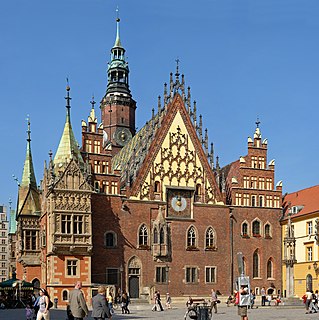| Łososiowice | |
|---|---|
| Village | |
| Coordinates: 51°18′N16°39′E / 51.300°N 16.650°E | |
| Country | |
| Voivodeship | Lower Silesian |
| County | Wołów |
| Gmina | Wołów |
| Population | 219 |
Łososiowice [wɔsɔɕɔˈvit͡sɛ] (German : Losswitz) is a village in the administrative district of Gmina Wołów, within Wołów County, Lower Silesian Voivodeship, in south-western Poland. [1] The earliest mention concerning Łososiowice dates from 1208. [2] It was destroyed in 1431 by the Hussite forces. In 1939 it had a population of 395. Prior to 1945 it was in Germany.

German is a West Germanic language that is mainly spoken in Central Europe. It is the most widely spoken and official or co-official language in Germany, Austria, Switzerland, South Tyrol (Italy), the German-speaking Community of Belgium, and Liechtenstein. It is also one of the three official languages of Luxembourg and a co-official language in the Opole Voivodeship in Poland. The languages which are most similar to German are the other members of the West Germanic language branch: Afrikaans, Dutch, English, the Frisian languages, Low German/Low Saxon, Luxembourgish, and Yiddish. There are also strong similarities in vocabulary with Danish, Norwegian and Swedish, although those belong to the North Germanic group. German is the second most widely spoken Germanic language, after English.
Gmina Wołów is an urban-rural gmina in Wołów County, Lower Silesian Voivodeship, in south-western Poland. Its seat is the town of Wołów, which lies approximately 38 kilometres (24 mi) north-west of the regional capital Wrocław.

Wołów County is a unit of territorial administration and local government (powiat) in Lower Silesian Voivodeship, south-western Poland. It came into being on January 1, 1999, as a result of the Polish local government reforms passed in 1998. The county covers an area of 675 square kilometres (261 sq mi). Its administrative seat is the town of Wołów, although the county also contains the slightly larger town of Brzeg Dolny.
There is a baroque church from 1701 built there, with an inside matroneum. It has three tombstones of Stober family. It had a functioning Roman Catholic parish until 1945. The last pastor of the village, Alois Pohl, died probably during the Soviet offensive of 1945.

A matroneum in architecture is a gallery on the interior of a building, originally intended to accommodate women.
It lies approximately 5 kilometres (3 mi) south of Wołów, and 34 kilometres (21 mi) north-west of the regional capital Wrocław.

Wrocław is a city in western Poland and the largest city in the historical region of Silesia. It lies on the banks of the River Oder in the Silesian Lowlands of Central Europe, roughly 350 kilometres (220 mi) from the Baltic Sea to the north and 40 kilometres (25 mi) from the Sudeten Mountains to the south. The population of Wrocław in 2018 was 639,258, making it the fourth-largest city in Poland and the main city of Wrocław agglomeration.
The village has a population of 219.





